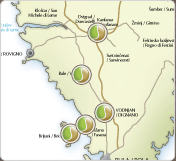
- Sečovlje Salt Pans - Dragonja River Valley
- Sv. Peter - Nova vas - Padna
- Pomjan - Nature Park: Karst Edge - Socerb
- Črni Kal - Osp - Kubed
- Momjan - Grožnjan - Pietrapelosa - Mirna
- Baštija - Kostanjica - Parenzana
- Oprtalj - Završje - Livade - Zrenj
- Istarske toplice - Motovun Forest - Višnjan
- Cave Mramornica - Feštini Kingdom - Cave Baredine
- Lim Bay - Kloštar - Kontija - Dvigrad
- Kanfanar - Bale - Palud - Vodnjan - Brijuni - Fažana
- Svetvinčenat - Tinjan - Pićan - Gračišće
- Belaj - Šumber - Kožljak - Paz
- Čepićko Field - Kršan - Boljun Castle - Lupoglav
- Plomin - Kvarner Gulf - Brseč
- Nature park Učka - Mošćenice
Kanfanar - Bale - Palud - Vodnjan - Brijuni - Fažana
Bale
It is a town of turbulent past, standing on the hill Mon Perin. On the remains of a prehistoric hill-fort, the Romans built a fortification Castrum Vallis. Historic documents, remains of Roman edifices, bronze coins and other finds prove that Bale fortification protected salt pans and sections of the Via Flavia leading from Pula to Poreč, from frequent incursions of neighboring inhabitants from the interior. In the Middle Ages the Roman castrum grew into a town fortified by walls under the Aquileians. The history of its rulers continues under Byzantium, the Lombards, and the Frankish king Pepin the Short, his son Charlemagne, while in the 14th c. it is part of the Venetian Republic. This was followed by the Austrian and French domination. The old town core is protected by law because of the historic and architectural value of sacral edifices. Namely, the town gate, narrow circular stone streets and buildings with elements of the Venetian Gothic, especially the Bembo Palace or Bembo Castle, where during renovation Bronze Age objects were found in the cellars. Because of Bembo’s vulnerability, the historic core was protected by three rings of walls and some ten towers. It has a nice town hall with loggia, displaying interesting coats of arms of the nobility and the Parish Church of St. Julian from the 19th c. built on the remains of a basilica about 1000 years earlier, that keeps a stone sarcophagus from the 8th c. decorated with a pre-Romanesque relief. The Church of the Holy Spirit from the 15th c. has a roof covered by stone slates and inside bears remains of Late Gothic frescoes, and the Church of St. Anthony the Abbot dates from the 14th c.
Bale tempts visitors with its natural attractions: in 1985 fossil remains of a dinosaur were found in the nearby bay. Precisely, it was a brachiosaurus that lived 130 million years ago. The finds were later completed by bones of a dinosaur and other prehistoric animals from the Mesozoic.
Apart from this, Bale possesses yet another fantastic collection: that of swamp birds from Palud, the nearby ornithological reserve. In the 1980s, as many as 176 species that inhabit the area of Palud were caught, stuffed and scientifically interpreted. The inhabitants of Bale are rightly proud of another treasure, charming statistics: in their intact nature there are as many as 400 butterfly species!


















